厦门大学:《海洋浮游生物学》课程教学资源(课件讲稿)第17章 Diurnal vertical migration(DVM)

Chapter 17 Diurnal vertical migration ◼ Diurnal vertical migration is a very common phenomenon. ◼ A few examples
Chapter 17 Diurnal vertical migration ◼ Diurnal vertical migration is a very common phenomenon. ◼ A few examples

Changes in the abundance of the copepod Calanus finmarchicus in the surface, between 06:00 and 14:00 h during 6 weeks from 21st June to 11thAugust, 1991, off Californian coast
Changes in the abundance of the copepod Calanus finmarchicus in the surface, between 06:00 and 14:00 h during 6 weeks from 21st June to 11thAugust, 1991, off Californian coast

§17.1 Characteristics diurnal vertical migration of zooplankton ◼ samples of night plankton at the surface are notably different from those taken during the day, not only in their faunistic composition but also quantitatively. ◼ The number of ind. colleted in the surface layers become ten times higher between 16:00 and 20:00pm. ◼ The only possible explanation of these variations is vertical migration, representing a rhythm of 24h
§17.1 Characteristics diurnal vertical migration of zooplankton ◼ samples of night plankton at the surface are notably different from those taken during the day, not only in their faunistic composition but also quantitatively. ◼ The number of ind. colleted in the surface layers become ten times higher between 16:00 and 20:00pm. ◼ The only possible explanation of these variations is vertical migration, representing a rhythm of 24h

Diurnal vertical distribution of the copepod C. finmarchicus females in Loch Fyne, Clyde Sea, Scotland
Diurnal vertical distribution of the copepod C. finmarchicus females in Loch Fyne, Clyde Sea, Scotland
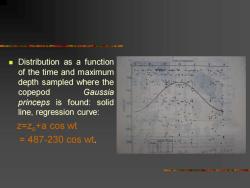
◼ Distribution as a function of the time and maximum depth sampled where the copepod Gaussia princeps is found: solid line, regression curve: z=zo+a cos wt = 487-230 cos wt
◼ Distribution as a function of the time and maximum depth sampled where the copepod Gaussia princeps is found: solid line, regression curve: z=zo+a cos wt = 487-230 cos wt
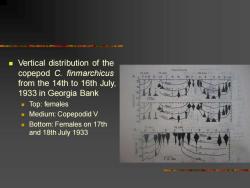
◼ Vertical distribution of the copepod C. finmarchicus from the 14th to 16th July, 1933 in Georgia Bank ◼ Top: females ◼ Medium: Copepodid V ◼ Bottom: Females on 17th and 18th July 1933
◼ Vertical distribution of the copepod C. finmarchicus from the 14th to 16th July, 1933 in Georgia Bank ◼ Top: females ◼ Medium: Copepodid V ◼ Bottom: Females on 17th and 18th July 1933
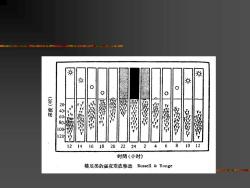
女 汝 本 * (S)樹账 00000020 12 1 6 18 20 22 24 2 6 8 10 12 时間(小时) 橈足类的昼夜垂直移动 Russell Yonge

Daylight 20 40 (w)ude 60 0 100 120 4 PM 10PM 4AM 10 AM 4 PM FIGURE 14.22 The depth distribution at different times of day of a vertically migrating copepod
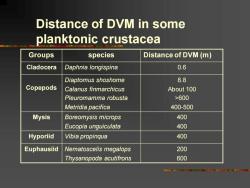
Distance of DVM in some planktonic crustacea Groups species Distance of DVM (m) Cladocera Daphnia longispina 0.6 Copepods Diaptomus shoshome Calanus finmarchicus Pleuromamma robusta Metridia pacifica 8.8 About 100 >600 400-500 Mysis Boreomysis microps Eucopia unguiculata 400 400 Hyporiid Vibia propinqua 400 Euphausiid Nematoscelis megalops Thysanopoda acutifrons 200 600
Distance of DVM in some planktonic crustacea Groups species Distance of DVM (m) Cladocera Daphnia longispina 0.6 Copepods Diaptomus shoshome Calanus finmarchicus Pleuromamma robusta Metridia pacifica 8.8 About 100 >600 400-500 Mysis Boreomysis microps Eucopia unguiculata 400 400 Hyporiid Vibia propinqua 400 Euphausiid Nematoscelis megalops Thysanopoda acutifrons 200 600
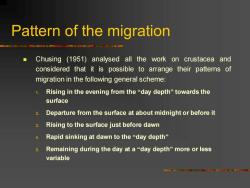
Pattern of the migration ◼ Chusing (1951) analysed all the work on crustacea and considered that it is possible to arrange their patterns of migration in the following general scheme: 1. Rising in the evening from the “day depth” towards the surface 2. Departure from the surface at about midnight or before it 3. Rising to the surface just before dawn 4. Rapid sinking at dawn to the “day depth” 5. Remaining during the day at a “day depth” more or less variable
Pattern of the migration ◼ Chusing (1951) analysed all the work on crustacea and considered that it is possible to arrange their patterns of migration in the following general scheme: 1. Rising in the evening from the “day depth” towards the surface 2. Departure from the surface at about midnight or before it 3. Rising to the surface just before dawn 4. Rapid sinking at dawn to the “day depth” 5. Remaining during the day at a “day depth” more or less variable
按次数下载不扣除下载券;
注册用户24小时内重复下载只扣除一次;
顺序:VIP每日次数-->可用次数-->下载券;
- 厦门大学:《海洋浮游生物学》课程教学资源(课件讲稿)第16章 vertical distribution.ppt
- 厦门大学:《海洋浮游生物学》课程教学资源(课件讲稿)第15章 geographic distribution.ppt
- 厦门大学:《海洋浮游生物学》课程教学资源(课件讲稿)第14章 seasonal distribution.ppt
- 厦门大学:《海洋浮游生物学》课程教学资源(课件讲稿)第13章 Adaptation of pelagic life.ppt
- 厦门大学:《海洋浮游生物学》课程教学资源(课件讲稿)第12章 浮游幼体.pdf
- 厦门大学:《海洋浮游生物学》课程教学资源(课件讲稿)第11章 其他浮游生物.pdf
- 厦门大学:《海洋浮游生物学》课程教学资源(课件讲稿)第10章 被囊动物.pdf
- 河南科技学院:《微生物学》课程教学资源(PPT课件)第九章 传染与免疫.ppt
- 河南科技学院:《微生物学》课程教学资源(PPT课件)第八章 微生物的生态.ppt
- 河南科技学院:《微生物学》课程教学资源(PPT课件)第七章 微生物的遗传变异与育种.ppt
- 河南科技学院:《微生物学》课程教学资源(PPT课件)第六章 微生物的生长与控制.ppt
- 河南科技学院:《微生物学》课程教学资源(PPT课件)第五章 微生物的代谢.ppt
- 河南科技学院:《微生物学》课程教学资源(PPT课件)第四章 微生物的营养和培养基.ppt
- 河南科技学院:《微生物学》课程教学资源(PPT课件)第三章 病毒(Viruses)和亚病毒(virusoid).ppt
- 河南科技学院:《微生物学》课程教学实验指导书(共十一个实验).doc
- 河南科技学院:《微生物学》课程教学资源(PPT课件)第二章 真核微生物的形态和构造.ppt
- 河南科技学院:《微生物学》课程教学实验室主要设备.doc
- 河南科技学院:《微生物学》课程教学资源(PPT课件)第一章 原核微生物的形态和构造.ppt
- 河南科技学院:《微生物学》课程教学实验常用基本操作技术.doc
- 河南科技学院:《微生物学》课程教学资源(PPT课件)微生物学实验(讲稿,主讲:王振河).ppt
- 厦门大学:《海洋浮游生物学》课程教学资源(课件讲稿)第18章 Plankton and Fishery.ppt
- 厦门大学:《海洋浮游生物学》课程教学资源(课件讲稿)第01章 硅藻门.pdf
- 厦门大学:《海洋浮游生物学》课程教学资源(课件讲稿)第02章 甲藻门.pdf
- 厦门大学:《海洋浮游生物学》课程教学资源(课件讲稿)第03章 其他海洋浮游植物.pdf
- 厦门大学:《海洋浮游生物学》课程教学资源(课件讲稿)第04章 原生动物.pdf
- 厦门大学:《海洋浮游生物学》课程教学资源(课件讲稿)第05章 腔肠动物.ppt
- 厦门大学:《海洋浮游生物学》课程教学资源(课件讲稿)第06章 栉水母.pdf
- 厦门大学:《海洋浮游生物学》课程教学资源(课件讲稿)第07章 浮游甲壳动物 Planktonic Crustacea 第1节 绪论.pdf
- 厦门大学:《海洋浮游生物学》课程教学资源(课件讲稿)第07章 浮游甲壳动物 Planktonic Crustacea 第2节 枝角类.ppt
- 厦门大学:《海洋浮游生物学》课程教学资源(课件讲稿)第07章 浮游甲壳动物 Planktonic Crustacea 第3节 桡足类 1/2.pdf
- 厦门大学:《海洋浮游生物学》课程教学资源(课件讲稿)第07章 浮游甲壳动物 Planktonic Crustacea 第3节 桡足类 2/2.pdf
- 厦门大学:《海洋浮游生物学》课程教学资源(课件讲稿)第07章 浮游甲壳动物 Planktonic Crustacea 第4节 磷虾类.pdf
- 厦门大学:《海洋浮游生物学》课程教学资源(课件讲稿)第07章 浮游甲壳动物 Planktonic Crustacea 第5节 糠虾类.pdf
- 厦门大学:《海洋浮游生物学》课程教学资源(课件讲稿)第07章 浮游甲壳动物 Planktonic Crustacea 第6节 端足类.pdf
- 厦门大学:《海洋浮游生物学》课程教学资源(课件讲稿)第07章 浮游甲壳动物 Planktonic Crustacea 第7节 樱虾类.pdf
- 厦门大学:《海洋浮游生物学》课程教学资源(课件讲稿)第08章 浮游软体动物.pdf
- 厦门大学:《海洋浮游生物学》课程教学资源(课件讲稿)第09章 毛颚动物.pdf
- 厦门大学:《海洋浮游生物学》课程教学资源(课件讲稿)绪论 Marine Planktology(主讲:曹文清、郭东晖).pdf
- 齐鲁工业大学(山东轻工业学院):《生物工艺学》课程教学资源(PPT课件)第一章 生物工艺学概论 biotechnologh.ppt
- 齐鲁工业大学(山东轻工业学院):《生物工艺学》课程教学资源(PPT课件)第二章 生物工业菌种.ppt
